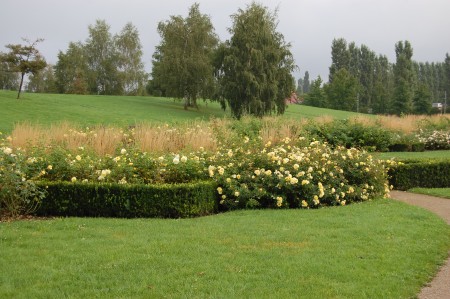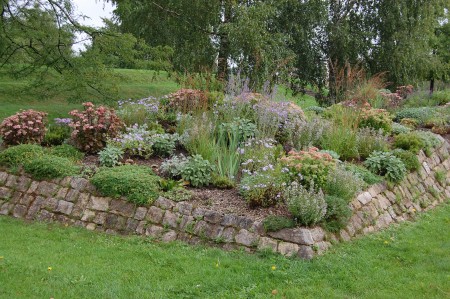Basking in sunshine, while England gets a drenching, I’m in Potsdam (just outside Berlin) for a very brief visit as I have been invited by a group of students at the Max Planck Institute for Molecular Plant Physiology to do a lecture for a conference they have organized. Looking at the list of other lecturers, I am clearly here as the entertainment. More about this later.
Years ago, 2000, I came here on my first trip to Berlin with my son Kieran for a Bundesgartenschau (Federal Garden Show), one of the great biennial garden extravaganzas the Germans are so good at. The show was on the Bornstedter Feld which had been a barracks and had seen plenty of industrial-scale goosestepping for centuries. I don’t have much memory of it, possibly because of the need to keep a (then teenage) lad on board and vaguely interested. All I remember were some brilliant giant weatherproof cushions in army camouflage and some rather weird pyramids planted up with sun-loving plants. I loved the cushions, it was like modern peace-loving Germany mocking its militaristic past – despite it being a wet day there were folk thoroughly slobbed out over them.
It is always interesting to go back to these old gardenshow sites, to see how well they have made the transition to permanent park-dom. This one has done very well and eleven years later I was won over by the weird pyramids in a way I hadn’t been before. Scattered around areas of lawn like the ruins of some lost civilization, they are planted with a variety of perennials and sub-shrubs, the kind of things which need lots of sun, and sharp drainage. They are actually rather a good way to grow this kind of thing somewhere the drainage is perhaps poor and I can imagine this working on a much smaller and domestic scale. Lichen has softened the stone now and there are a lot of wild plants growing in the mortar between the stones, and in fact some of the denizens of the planting beds have spread down too.

Opinions over whether grasses and conventionl roses work, but the colors here do - Calamagrostis Karl Foerster with some rather municipal roses at Bornstedter Feld.
I managed a visit too, to the Freundschaftsinsel (Friendship Island) which I had last been to, maybe 8 years ago, when it was looking a bit ‘post-communist’ with dwarf asters marching around like small armies. Nice to see how well it has fared too, the asterwehrmacht have been pushed back and there’s a rich variety of perennials, amazingly well-labelled. I wonder if it is used as a teaching garden – I’d love to hold a workshop here. What is special about this place was that it was laid out by master gardener/nurseryman/breeder Karl Foerster in the 1950s, and is one of the few public places laid out under the Soviet regime which is worth a place in the garden history books. There is a lovely statue of a young gardener (dated 1963) – it has to be said that in the capitalist west/Free World I have never seen a statue of a gardener in a garden.
Back to the Molecular Plant Physiologists, who were a friendly and enthusiastic bunch. I was here to do a lecture on the history of plant breeding, to give a bit of historical perspective to specialists in a field which is so cutting-edge that it has little sense of its past. Some great people, but I can hardly keep up with what anyone is talking about – this is a very specialized world. The other lecturers included people who are working on developments with huge ramifications: breeding Artemisia for production of anti-malarial drugs, plant production of a vaccine against HPV (the virus which causes most cervical cancer), salt-tolerant wheat etc etc, nearly all of them public sector (rather than corporate). Much of this involves what has become known as genetic modification, and there was a strong feeling of suppressed anger and despair at the attitudes of those who oppose GM technology, and the incredibly expensive and long-winded process of regulation which many countries, the EU in particular, impose on GM plants which not only limits their use but also means that only multinational supercorporations can afford to develop them, despite the utterly threadbare nature of the anti-GM case. I do wish people could get real about this issue.
Somewhat less vital for the world than new breeds of wheat etc. but jolly nice to have all the same, are apricots, peaches and other exotic fruit in places way beyond where they would normally be expected. Read my own blog to find out how well we’ve done this year despite a miserable summer.




